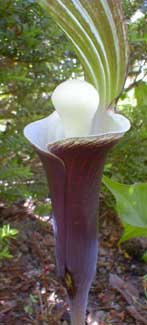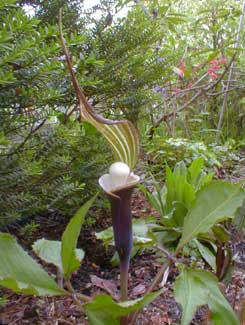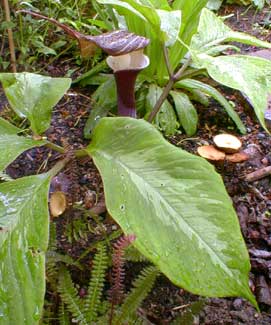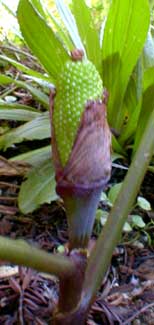
Snow Rice-cake Plant
Japanese Jack-in-the-Pulpit
"Jack was a swarthy, swaggering son-of-a-gun."
-Carl Sandburg
(1878-1967)
(1878-1967)
 A burgundy "horn" pops out of the ground in late March or early April, from which leaves & inflourescence develop.
A burgundy "horn" pops out of the ground in late March or early April, from which leaves & inflourescence develop.A large & robust species, Arisaema sikokianum grows eighteen or twenty & occasionally thirty inches in height, with two sea-green divided leaves that each look like three leaves, & a large open pitcher-shaped inflorescence.
The hood or lid of the spathe's "pitcher" displays itself in a broad, fully open position revealing its chocolate-purple & verticle white inner striping, & in the "cup" of the pitcher there arises a brightly snow-white spadix.
The base of the pitcher itself is chocolate-purple, & the inner walls are snow white. It almost looks like a fancy icecream cup of some kind & Granny Artemis & I call it our "Ice Cream Cone Pulpit." To the Japanese it invokes a cup holding snowy rice-cake.
 When these were first imported in the 1990s, young plants were going for a hundred dollars each. The ease by which these beauties sold even for so much induced many specialists to begin propogating them, so that the inevitable competition for sales has brought the prices down to around twenty dollars. So we got two of them at last, knowing the market is never apt to be so flooded with such special-interest shade plants, so prices aren't apt to fall further.
When these were first imported in the 1990s, young plants were going for a hundred dollars each. The ease by which these beauties sold even for so much induced many specialists to begin propogating them, so that the inevitable competition for sales has brought the prices down to around twenty dollars. So we got two of them at last, knowing the market is never apt to be so flooded with such special-interest shade plants, so prices aren't apt to fall further. The leaves of one of our two Rice Cake Pulpits are a smooth shiny even green. The other ones leaves are a duller darker green with white marking through the center of each of the three sections of both leaves. The third photo shows the marked variegated leaves of this latter plant.
The leaves of one of our two Rice Cake Pulpits are a smooth shiny even green. The other ones leaves are a duller darker green with white marking through the center of each of the three sections of both leaves. The third photo shows the marked variegated leaves of this latter plant.The seedheads look like small cobs of popcorn starting out green in July & August, ripening to yellow by September or October, then by November or December they are bright orange-red. The leaves wilt away long before the seedpod has ripened.
The inflouresences are single-sexed & there needs to be both sexes present simultaneously to develop the cob of seeds. The flower can change its sex from year to year. It can be pollinated by closely related species.
There can be 300 or over a thousand seeds on one cob. They have a low rate of germination, however, & seeds that do germinate can take a very long while to get round to it. Percentages & speed are enhanced if the seeds are harvested in December & stored at room temperature for one month, then planted in shady situations.
Neutral to acid soil in a moist, well-draining, protected location in dappled sun to partial or nearly full shade. It's one of the more cold-hardy of the large jack-in-the-pulpits & should do well to Zone 5.
Hachijo Island Jack-in-the-Pulpit
(A. hachijoense)